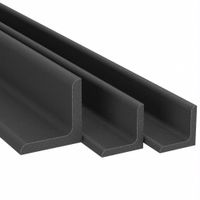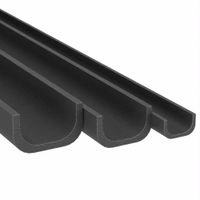Call +(254) 703 030 000 / 751 483 999 / 721 704 777
- Home
- Raw Materials
- Fiberglass Carbon Fiber Composites
- Structural Fiberglass Reinforced Plastics
- Fiberglass Angles Channels Beams
.....Read More
Frequently Asked Questions
What are the advantages of using fiberglass over metal?
Fiberglass offers several advantages over metal:
1. **Corrosion Resistance**: Unlike metal, fiberglass does not rust or corrode, making it ideal for use in environments exposed to moisture, chemicals, or saltwater.
2. **Lightweight**: Fiberglass is significantly lighter than most metals, which can lead to easier handling, reduced transportation costs, and improved fuel efficiency in vehicles and aircraft.
3. **Strength-to-Weight Ratio**: Fiberglass provides a high strength-to-weight ratio, offering substantial strength without the added weight of metal, making it suitable for applications where weight is a critical factor.
4. **Thermal Insulation**: Fiberglass has low thermal conductivity, providing better insulation properties compared to metals, which can help in reducing energy costs in buildings and maintaining temperature control in various applications.
5. **Electrical Insulation**: As a non-conductive material, fiberglass is an excellent electrical insulator, making it safer for use in electrical and electronic applications.
6. **Design Flexibility**: Fiberglass can be molded into complex shapes and sizes, offering greater design flexibility and the ability to create intricate parts that might be difficult or costly to produce with metal.
7. **Cost-Effectiveness**: In many cases, fiberglass can be more cost-effective than metal, especially when considering the long-term savings from reduced maintenance, corrosion resistance, and energy efficiency.
8. **Durability**: Fiberglass is resistant to a wide range of environmental factors, including UV radiation, extreme temperatures, and impact, contributing to a longer lifespan and reduced maintenance needs.
9. **Non-Magnetic**: Fiberglass is non-magnetic, making it suitable for applications where magnetic interference must be avoided.
10. **Aesthetic Versatility**: Fiberglass can be easily colored and finished to achieve various aesthetic effects, offering more options for customization in design.
How is fiberglass made?
Fiberglass is made through a process that involves several key steps. First, raw materials such as silica sand, limestone, and soda ash are combined with other additives to form a batch. This mixture is then melted in a furnace at temperatures around 1,700°C (3,092°F) to create molten glass.
Once the glass is molten, it is extruded through a bushing, a device with numerous small holes, to form fine filaments. These filaments are rapidly cooled and solidified as they emerge, typically by being sprayed with a sizing solution that helps protect the fibers and improve their bonding with resins.
The continuous filaments are then gathered into strands and wound onto spools. These strands can be further processed into various forms, such as chopped fibers, woven mats, or rovings, depending on the intended application.
For producing fiberglass insulation, the fibers are blown into a mat and bonded with a resin, usually a thermosetting polymer like phenolic resin, which is then cured to form a stable structure. The resulting product is cut into batts or rolls for use in thermal and acoustic insulation.
In the case of fiberglass-reinforced plastics, the fibers are combined with a resin matrix, such as polyester, epoxy, or vinyl ester, to create composite materials. These composites are molded into desired shapes and cured to form strong, lightweight components used in various industries, including automotive, aerospace, and construction.
Quality control measures are implemented throughout the manufacturing process to ensure the consistency and performance of the fiberglass products.
What are the common applications of fiberglass in construction?
Fiberglass is widely used in construction due to its strength, durability, and versatility. Common applications include:
1. **Insulation**: Fiberglass is a popular choice for thermal and acoustic insulation in walls, roofs, and floors. Its fibrous structure traps air, reducing heat transfer and noise.
2. **Roofing**: Fiberglass is used in roofing materials like shingles and panels. It provides weather resistance, durability, and is lightweight, making it easy to install.
3. **Reinforced Plastics**: Fiberglass-reinforced plastics (FRP) are used in construction for making doors, windows, and cladding. They offer high strength-to-weight ratios and resistance to corrosion.
4. **Structural Components**: Fiberglass is used in structural elements such as beams, columns, and panels. Its high tensile strength and resistance to environmental factors make it suitable for load-bearing applications.
5. **Pipes and Tanks**: Fiberglass is used to manufacture pipes and tanks for water, sewage, and chemical storage. Its corrosion resistance and lightweight nature make it ideal for these applications.
6. **Decorative Elements**: Fiberglass is used for decorative architectural elements like cornices, columns, and facades. It can be molded into intricate shapes and is easy to paint and finish.
7. **Rebar**: Fiberglass rebar is used as an alternative to steel rebar in concrete reinforcement. It is non-corrosive, lightweight, and has a high tensile strength.
8. **Skylights and Windows**: Fiberglass is used in the frames of skylights and windows due to its thermal efficiency and resistance to warping and rotting.
9. **Soundproofing**: Fiberglass panels are used in soundproofing applications to reduce noise transmission in buildings.
10. **Molded Products**: Fiberglass is used to create custom-molded products like bathtubs, shower stalls, and sinks, offering durability and ease of maintenance.
How does fiberglass compare to other materials in terms of strength and weight?
Fiberglass is a composite material made from fine glass fibers and a resin matrix, offering a unique balance of strength and weight. Compared to metals like steel and aluminum, fiberglass is significantly lighter, which makes it advantageous in applications where weight reduction is crucial, such as in automotive and aerospace industries. While not as strong as steel in terms of tensile strength, fiberglass offers a high strength-to-weight ratio, making it a competitive alternative for certain structural applications.
In comparison to carbon fiber, another composite material, fiberglass is generally less strong and stiff. However, it is also much more cost-effective, making it a popular choice for applications where budget constraints are a concern. Carbon fiber is preferred in high-performance applications where maximum strength and minimal weight are critical, despite its higher cost.
When compared to traditional materials like wood, fiberglass offers superior durability and resistance to environmental factors such as moisture, UV radiation, and temperature fluctuations. This makes it an ideal choice for outdoor applications, including marine and construction industries.
Fiberglass also excels in terms of versatility and ease of fabrication. It can be molded into complex shapes and is available in various forms, such as mats, woven fabrics, and chopped strands, allowing for tailored mechanical properties to suit specific needs.
Overall, fiberglass provides a balanced combination of strength, weight, cost, and durability, making it a versatile material for a wide range of applications. Its performance relative to other materials depends on the specific requirements of the application, including factors like cost, environmental conditions, and mechanical demands.
What are the safety precautions when working with fiberglass?
1. **Personal Protective Equipment (PPE):** Wear safety goggles to protect your eyes from fiberglass dust and particles. Use a dust mask or respirator to prevent inhalation of fibers. Wear gloves to protect your hands from irritation and cuts. Long-sleeved clothing and long pants should be worn to minimize skin exposure.
2. **Ventilation:** Ensure the workspace is well-ventilated to disperse fiberglass dust and fumes. Use exhaust fans or work outdoors if possible.
3. **Handling and Cutting:** Use tools specifically designed for cutting fiberglass to minimize dust. Wet the fiberglass before cutting to reduce airborne particles. Handle fiberglass with care to avoid splinters.
4. **Cleaning and Disposal:** Clean the workspace with a vacuum equipped with a HEPA filter to capture fine particles. Avoid sweeping, which can stir up dust. Dispose of fiberglass waste in sealed bags according to local regulations.
5. **Skin Care:** Wash exposed skin with cold water to close pores and remove fibers. Avoid hot water, which can open pores and embed fibers. Use a gentle soap to prevent irritation.
6. **First Aid:** If fiberglass gets into the eyes, rinse immediately with water. For skin irritation, wash the area thoroughly and apply a soothing lotion if needed. Seek medical attention if irritation persists.
7. **Training and Awareness:** Ensure all workers are trained in handling fiberglass safely and are aware of the potential health risks. Regularly review safety procedures and update as necessary.
8. **Storage:** Store fiberglass materials in a dry, cool place to prevent degradation and reduce the risk of airborne fibers.
9. **Signage:** Post warning signs in areas where fiberglass is being used to alert others of potential hazards.
How do you cut and shape fiberglass materials?
To cut and shape fiberglass materials, follow these steps:
1. **Preparation**: Wear protective gear, including gloves, goggles, and a dust mask, to protect against fiberglass dust and fibers.
2. **Marking**: Use a marker or chalk to outline the desired shape on the fiberglass surface. Ensure measurements are accurate.
3. **Cutting**:
- For thin sheets, use a utility knife or heavy-duty scissors. Score the surface with the knife and snap it along the line.
- For thicker materials, use a jigsaw with a fine-toothed blade or a circular saw with a diamond or carbide-tipped blade. Ensure the tool is set to a low speed to prevent overheating and fraying.
4. **Sanding**: Smooth the edges with sandpaper or a sanding block. Start with coarse grit and progress to finer grit for a smooth finish.
5. **Shaping**:
- For simple curves, use a rasp or file to gradually shape the fiberglass.
- For complex shapes, consider using a rotary tool with sanding or grinding attachments. Work slowly to avoid damaging the material.
6. **Finishing**: Clean the surface with a damp cloth to remove dust. If necessary, apply a resin or gel coat to seal and protect the edges.
7. **Safety and Cleanup**: Dispose of fiberglass dust and scraps properly. Clean tools and work area to prevent contamination.
By following these steps, you can effectively cut and shape fiberglass materials for various applications.
What are the environmental impacts of using fiberglass?
Fiberglass production and use have several environmental impacts. The manufacturing process involves the melting of raw materials like silica sand, limestone, and soda ash at high temperatures, which requires significant energy, often derived from fossil fuels, contributing to greenhouse gas emissions. The production also releases pollutants such as nitrogen oxides and sulfur oxides, which can contribute to air pollution and acid rain.
During the manufacturing process, particulate emissions can occur, potentially affecting air quality and posing health risks to workers. The use of resins and other chemicals in fiberglass production can lead to the release of volatile organic compounds (VOCs), which contribute to smog formation and have health implications.
Fiberglass is not biodegradable, leading to waste management challenges. Disposal in landfills can result in long-term environmental impacts, as it does not break down easily. Recycling fiberglass is possible but not widely practiced due to the complexity and cost involved, leading to a significant amount of waste.
In terms of usage, fiberglass insulation can improve energy efficiency in buildings, reducing the need for heating and cooling and thereby lowering energy consumption and associated emissions. However, improper installation or damage can release fibers into the air, posing respiratory risks.
Overall, while fiberglass has benefits in terms of energy efficiency, its production and disposal present environmental challenges that need to be managed through improved manufacturing processes, increased recycling efforts, and proper handling and installation practices.


